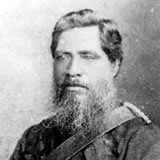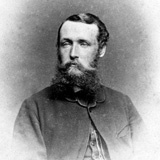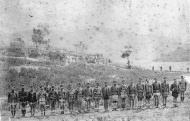Personal details
Full Name:
- Te Kooti Arikirangi Te Turuki
Lifetime:
- ?–17 Apr 1893
 Te Kooti
Te Kooti
Te Kooti fought on the government side in the New Zealand Wars before being exiled to the Chatham Islands on charges of espionage. He later escaped back to the mainland and fought a long guerilla war against government forces.
Read more...Events In History
-
 14 February 1872Te Kooti's last clash with government forces
14 February 1872Te Kooti's last clash with government forcesGovernment forces led by Captain George Preece tackled Te Kooti for the last time above the Mangaone stream, just south of Lake Waikaremoana. A few months later Te Kooti withdrew to Te Rohe Pōtae (the King Country). Read more...
-
 6 May 1869Colonial troops invade the Urewera
6 May 1869Colonial troops invade the UreweraThe invasion of the Urewera was intended to punish Tūhoe for supporting Te Kooti Rikirangi, whose ‘rebel’ force it had sheltered after its defeat at Ngatapa, inland from Poverty Bay, in January. Read more...
-
 4 January 1869Te Kooti defeated at Ngātapa
4 January 1869Te Kooti defeated at NgātapaPursued by kūpapa and colonial troops to Ngātapa, an old hilltop pā inland from Poverty Bay, Te Kooti narrowly avoided capture after a four-day siege. Most of those with him were captured and many were executed the following day. Read more...
-
 10 November 1868Te Kooti attacks Matawhero
10 November 1868Te Kooti attacks MatawheroTe Kooti and his supporters attacked Matawhero in Poverty Bay, killing approximately 60 people – roughly equal numbers of Māori and Pākehā. Read more...
-
 4 July 1868Te Kooti escapes from the Chathams
4 July 1868Te Kooti escapes from the ChathamsTe Kooti and 300 followers captured the schooner Rifleman and sailed for New Zealand. The fugitives landed at Whareongaonga, just south of Poverty Bay, six days later. Read more...
-
 5 June 1866Te Kooti deported to Chathams
5 June 1866Te Kooti deported to ChathamsThe future prophet and military leader was deported with Pai Mārire prisoners to the Chatham Islands. He had been accused of spying for the enemy while fighting with government troops. Read more...
Articles
Pai Marire

Pai Marire (goodness and peace) was one of several Maori Christian faiths to emerge in the 19th century. Like many others, it was closely tied to issues of land and politics.
- Page 1 - Pai MārirePai Marire (goodness and peace) was one of several Maori Christian faiths to emerge in the 19th century. Like many others, it was closely tied to issues of land and
Te Kooti's war

Te Kooti was one of the most significant Māori leaders of the 19th century. For nearly four years he waged a guerrilla war unlike any previous conflict in the New Zealand Wars. His influence continues to be felt in the eastern Bay of Plenty and East Coast, where his Ringatū faith remains strong.
-
Page 2 – Clashes of faith
A civil war erupted on the East Coast in the winter of 1865 when Hauhau evangelists ignored a warning not to enter Ngāti Porou territory.
-
Page 3 – Exile and deliverance
Chatham Island would be home for Te Kooti and his fellow prisoners for two years from 1866.
-
Page 4 – Te Kooti's war begins
In July 1868 Major Reginald Biggs sent three Māori emissaries to Whareongaonga. Te Kooti and his followers were told to surrender all their weapons and ‘await the decision of
-
Page 5 – Matawhero
Shortly before midnight on 9 November 1868 Te Kooti and around 100 men moved on Matawhero. By dawn nearly 60 people from Matawhero and the adjacent kāinga had been killed.
-
Page 6 – Ngātapa
An attack by a combined Ngāti Porou-government force saw Te Kooti retreat inland to the ancient hilltop pā of Ngātapa.
-
Page 7 – Te Kooti goes to Te Kūiti
Te Kooti was invited to the King Country only if he came in peace. He responded defiantly that he was coming to ‘assume himself the supreme authority which he coming direct
-
Page 8 – Te Pōrere and retreat
On 25 September Te Kooti was defeated by a combined force of Ngāti Kahungunu, Te Arawa and Ngāti Tūwharetoa at Te Ponanga, near Tokaanu.
-
Page 9 – A Māori matter
Te Kooti's final decades
-
Page 10 – Further information
Links and books relating to Te Kooti's war
Treaty timeline

See some of the key events between 1800 and 1849 relating to the Treaty of Waitangi.
- Page 2 - Treaty events 1850-99See the key events between 1850 and 1899 relating to the Treaty of
New Zealand's 19th-century wars

War changed the face of New Zealand in the 19th century. Tens of thousands of Māori died in the intertribal Musket Wars from the 1810s to the 1830s. There were fewer deaths during the New Zealand Wars (1840s-1870s) between Māori and the Crown, but the consequences were still dire for many tribes.
-
Page 5 – End of the New Zealand Wars
The New Zealand Wars ended in 1872. European settlers prevailed through weight of numbers and economic power. By 1900, New Zealand was a settler society, with Māori pushed out
-
Page 8 – NZ Wars flags
For many Maori in the 19th century, the Union Jack was frequently viewed as a potent symbol of Great Britain's power in New Zealand. In the New Zealand Wars, Maori parties who
Related keywords
- new zealand wars
- gilbert mair
- george whitmore
- tuhoe
- armed constabulary
- rua kenana
- te kuiti
- painting
- william williams
- maori pa
- waerenga-a-hika
- matamata
- josiah firth
- maori leaders
- battle of te porere
- historic places
- lake rotokakahi
- lake waikaremoana
- george preece
- carving
- ngati porou
- chatham islands
- ngatapa
- new zealand cross
- maori
- napier
- hauhau
- matawhero
- gisborne
- marae
- ringatu
- maori weapons
- peka makarini
- whakatane
- NZ Wars memorial
- shipping
- george crosswell
- opepe
- roadside stories
- pai marire
- flags
- kingitanga
- rapata wahawaha
- ruatahuna
- riwha titokowaru
- te ua haumene
- king country
- taranaki
- war objects
- new zealand medal
- maori land
- ruakituri
- ngati tuwharetoa
- horonuku te heuheu
- rongowhakaata
- turanganui-a-kiwa
- ngati maru
- missionaries
- religion
- treaty of waitangi
- timeline
- land confiscation
- parihaka attack
- maori land court
-
Main image: Te Kooti's Little Spree
'Te Kooti's little spree, as told by extracts from telegrams and the daily papers'.


























